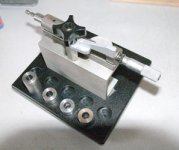M
Migs
Guest
Friends:
I've reloaded a lot on automatic presses, but I need some help. Now I have the Wilson dies, trimmer and the arbor press from Sinclair. (I reload .308)
Reading through the handout that came with each die (micrometer neck sizing and seating) I kind of figured out how each works, installed the bushing in the neck die, and assembled a couple bullets less powder, and dimension-wise the bullets look good. (So I sort of have the base sequence figured out.)
The dies came with a couple bases into which the dies fit. The taller base has two sides (of which I don't know what the funnel side is for.) The decaping pin is a bit tight per instructions, so how exactly do you use it? When and how do you use the other shorter base?
The plastic trimmer base (black plastic) has some circular places in the back that seem like places to park the dies (when you're not using them) so why doesn't the neck die fit in one of them? (Nor do the die bases)
I also have a die that is like a shell plate case holder - when do you use it?
At which point do you clean (I use that Never Dull polish wool) the brass? Before or after decaping? (Does Wilson have a little explanatory reloading sequence?)
So far after I have been using a small screwdriver to pry the case out of the dies - but I know this must NOT be the right way. I want to learn the right way before i scratch these fine looking tools.
I even read somewhere that in the decaping process you put the case in the die and first put it into the press up-side-down (how's that work?)
So as you can tell, I don't quite have the right work flow for these apparently wonderful dies.
Aside from answering the above questions, has someone written a kind of sequence on how to use them from start to finish?
I don't need to remind you that I am quite grateful for your comments. -Migs
I've reloaded a lot on automatic presses, but I need some help. Now I have the Wilson dies, trimmer and the arbor press from Sinclair. (I reload .308)
Reading through the handout that came with each die (micrometer neck sizing and seating) I kind of figured out how each works, installed the bushing in the neck die, and assembled a couple bullets less powder, and dimension-wise the bullets look good. (So I sort of have the base sequence figured out.)
The dies came with a couple bases into which the dies fit. The taller base has two sides (of which I don't know what the funnel side is for.) The decaping pin is a bit tight per instructions, so how exactly do you use it? When and how do you use the other shorter base?
The plastic trimmer base (black plastic) has some circular places in the back that seem like places to park the dies (when you're not using them) so why doesn't the neck die fit in one of them? (Nor do the die bases)
I also have a die that is like a shell plate case holder - when do you use it?
At which point do you clean (I use that Never Dull polish wool) the brass? Before or after decaping? (Does Wilson have a little explanatory reloading sequence?)
So far after I have been using a small screwdriver to pry the case out of the dies - but I know this must NOT be the right way. I want to learn the right way before i scratch these fine looking tools.
I even read somewhere that in the decaping process you put the case in the die and first put it into the press up-side-down (how's that work?)
So as you can tell, I don't quite have the right work flow for these apparently wonderful dies.
Aside from answering the above questions, has someone written a kind of sequence on how to use them from start to finish?
I don't need to remind you that I am quite grateful for your comments. -Migs


